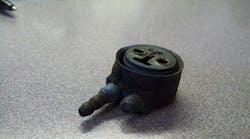Modular power delivery systems are standard equipment on most new vehicles. Designed appropriately, installed correctly and maintained diligently, a vehicle’s wiring harness and lighting system will provide decades of uninterrupted service.
However, electrical and lighting systems that are left largely unattended, and those that are improperly treated, can be rendered inoperable and may even have to be replaced.
Modular systems provide the flexibility of standardized connectors that snap together to accommodate the wide range of power delivery configurations required to meet the needs of today’s vehicles. Engineers can easily design modular electrical systems that simply branch off from a vehicle’s main electrical harness line.
A Weakness
The snap-together nature of a modular system is not only its strength, but also its weakness. Every connection point presents an opportunity for moisture and ultimately corrosion to take hold.
“Moisture and corrosion are literally forces of nature that have to be respected and dealt with from the onset of vehicle ownership,” says Brett Johnson, president and CEO, Optronics International (www.optronicsinc.com), a leading manufacturer and supplier of heavy duty LED vehicle lighting. “We know fleets that apply adhesive-lined heat-shrink tubing to all electrical connectors on the day they take possession of a vehicle.”
He recommends every fleet establish and adhere to a well-documented planned maintenance (PM) protocol, including the thorough examination of a vehicle’s entire electrical and lighting system beginning on day one.
If OEMs have positioned wiring and connectors in high-moisture areas, such as just above or behind tires, Johnson suggests that the fleet maintenance team may want to add ancillary protective coverings in the form of boots, plastic looms, moldings or tubing. These measures not only help reduce high-pressure moisture exposure, they diminish the potential damage that can be inflicted by rocks, road debris and ice accumulation that can place undue stress on wiring and connection points.
During the new vehicle inspection, maintenance professionals should make sure that all lighting is correctly installed and operating, he adds. They should look for wires and cables that are bent sharply and those that come into contact with metal edges, such as where wires pass through walls or into body cavities.
Dielectric grease can be added to grounding ring terminals that are improperly connected to a frame member and might otherwise produce a galvanic response caused by two dissimilar metals making contact.
“To the extent possible, corrections should be made and the system augmented as needed,” he says. “Any wiring that appears to be loosely hanging should be secured and if unused connectors are spotted, these should immediately be capped.”
System Integrity
Once a vehicle is in service, there needs to be a focus on seals, connection points and cable and wiring integrity, says Optronics’ Johnson.
“Just like people, electrical systems grow less resilient with age and are, therefore, more susceptible to injury and failure,” he explains. “Like people, environmental factors play a big role in system longevity.
“Savvy fleet maintenance managers who want to achieve the highest level of vehicle utility will customize their PM protocols to accommodate vehicles operating in regions with extreme heat, cold, moisture and chemicals.”
The simple mechanical action caused by a vehicle’s movement, acts on all its components, including lights, wiring and harnesses. Cabling that is continuously flexing may develop small cracks in its outer and inner insulation, and abrasions may occur where it comes in regular contact with metallic surfaces.
Those same physical forces can help usher moisture and corrosion throughout a vehicle’s entire electrical system, he points out.
“Connectors that were originally tightly sealed and protected with dielectric grease can loosen and their silicone oils may dry out,” he says. “Cables that bore tensile loads of ice may show signs of stress or failure where the cable and connector merge. Leaking lamp connections, broken lamp housings and lenses are also weak spots.
“One way or another, every electrical system sustains small injuries every day of its service life, and one way or another, moisture will find its way in.”
Brutal cold-weather conditions and chemicals may help to compromise an electrical system, but warmer weather amplifies the spread of corrosion, Johnson notes. Every 50 degrees F rise in temperature doubles the rate of corrosive activity. “Fleet maintenance staffs will want to pay close attention to electrical systems as summer approaches.”
Inspections
During regular inspections, maintenance technicians should do a standardized visual inspection, advises Johnson of Optronics. They should:
- First look for lighting failures and for broken and cracked lamps.
- Pay close attention to wires that make contact with any surface, including protective grommets.
- Make note of any abnormalities in the wiring insulation, such as cracks, oil residue or signs of corrosion activity.
He says “any sign of corrosion anyplace on the system may mean that the larger system has been compromised and the corrosion has already migrated.”
Trouble Signs
Like the rest of a vehicle’s modular system, LED lamps are designed to use dielectric grease, plus the designs of their modular connectors provide reservoirs to hold that grease. A system’s connectors must all be inspected regularly and the grease replenished as needed.
“In this day of long-lasting LED lighting, a lighting failure may be a sign of a systemic problem,” Optronics’ Johnson says. “Technicians should start at the site of the failed lamp and work their way in.
“It’s always best to begin electrical diagnostics at the periphery of the system, then move toward the harness system and, ultimately, the nose box. It’s also wise to begin from the rear of the trailer and work forward.”
He says a wiring harness problem usually boils down to three primary issues:
- Failure due to a grounded circuit
- Failure due to an open circuit
- Failure due to a short circuit
“Technicians should never use the pointed end of a circuit tester probe to puncture the insulation on any wire or cable,” stresses Johnson.
“Finally, every lamp, wire harness segment and connector should be visually inspected and any signs of corrosion, cracks and wear areas – and punctures noted and corrected immediately, in order to prevent corrosion from gaining a foothold and spreading.”




